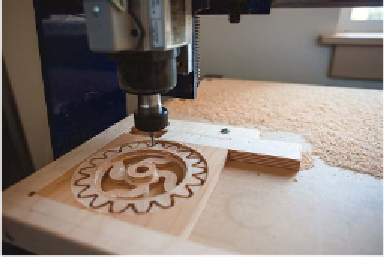Graphics Reference
In-Depth Information
Milling 3D Objects
20
The takeaway on subtractive vs. additive fabrication.
W
RITTEN
BY
T
OM
O
WAD
The Subtractive Equivalent
of 3DP
A CNC milling machine or router is the sub-
tractive equivalent of the 3D printer. For the
hobbyist, milling is inferior to printing in nu-
merous ways:
•
Milling inherently causes waste, and
without some sort of dust control, that
waste gets flung throughout the room.
•
Milling is more dangerous—while it's
possible that a plastic extruder might
overheat and catch fire, I've already had
a (minor) fire with my CNC router, and
there's the added danger of a blade spin-
ning at 20,000 rpm sending bits of itself,
or even your workpiece, flying at you.
•
A mill or router is necessarily larger and
heavier than a 3D printer and conse-
quently more expensive and more diffi-
cult to move. It requires a positioning
system that can maintain accuracy when
encountering resistance, and motors
powerful enough to drive it.
•
Software preparation is also more com-
plex for milling. After drawing the object
you wish to make in a CAD or 3D mod-
eling program, it's necessary to generate
There's a lot of well-deserved excitement
surrounding 3D printers, and for the avid
DIYer much of it is focused on their ability to
“self-replicate” by making their own parts.
But is a 3D printer the right tool for you?
A 3D printer's fabrication technique is addi-
tive—most of them use a hot plastic extrud-
er to “print” a plastic model. This contrasts
with subtractive fabrication tools, which
start with a solid block of material and use a
cutter to remove the excess. Subtractive fab-
rication is far more common than additive,
especially when working with metal and
wood. Lathes, mills, saws, drills, and other
CNCs like laser and vinyl cutters are all sub-
tractive tools.







